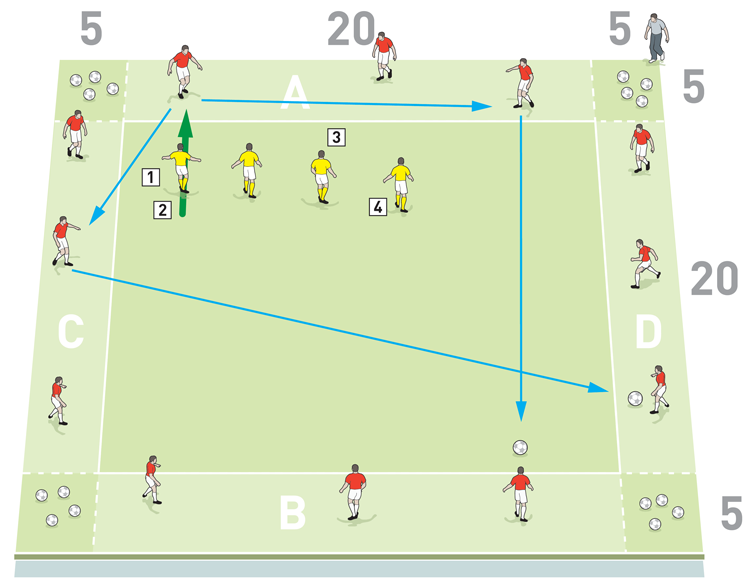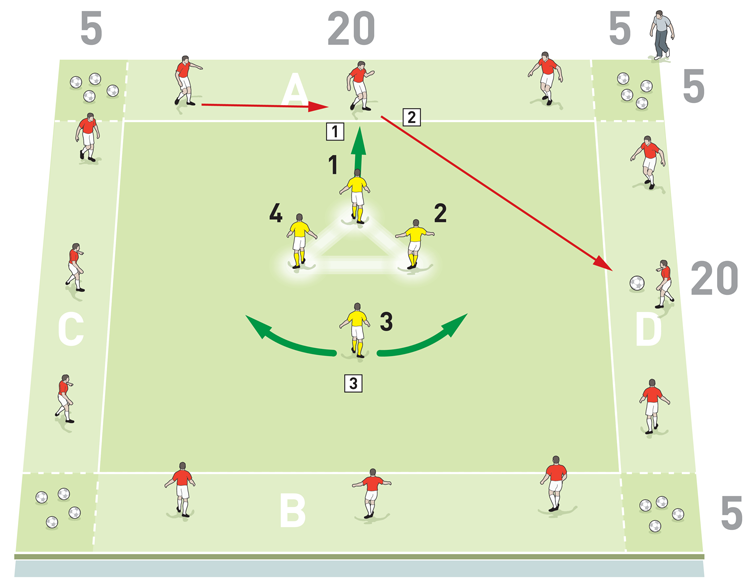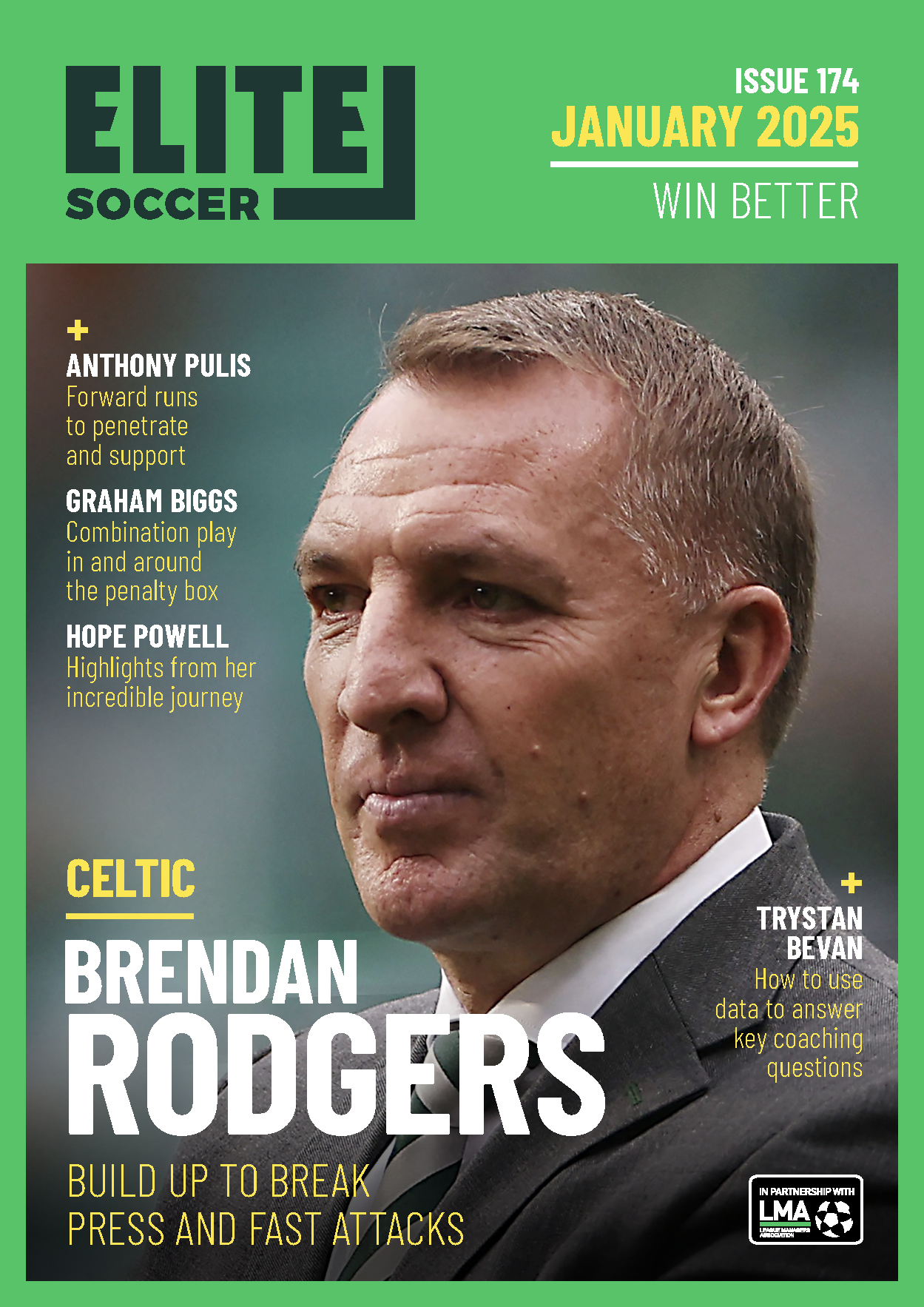You are viewing 1 of your 1 free articles
The art of pressing
Use this session to help develop the technique of pressing and encourage players to think about who they press, how they press and when they press.
| Area | Up to 70x60 yards |
| Equipment | Balls, bibs, cones, 2 full size goals |
| No. of Players | 16 players + 2 goalkeepers |
| Session Time | Total: 65mins, Multi-directional game: 25mins, Small-sided game: 40mins |
This session is all about coaching the art of the press, with an emphasis on the PAPP concept (Press Assess Press or Protect) and what triggers to look for when pressing.
The session helps to develop the technique of pressing and encourages players to think about who they press, how they press and when they press.
What do I get the players to do?
Multi-directional game
Set up an area of 20x20 yards with an added 5-yard channel on each side and a 5x5-yard box in each corner at the end of the channels. Start with four players inside the main area (the yellows) and 12 players on the outside – three in each channel (the reds). The outside players are two-touch and have to remain in their channels. Start with five balls in each of the corner boxes.
Play begins with one of the yellows fetching a ball from a corner box and starting unopposed passing at a high tempo, using just the players inside the area, as shown [1]. They are one or two-touch. After five or six passes, on the coach’s call the ball is played to any of the outside players to represent losing possession. The players on the outside must try to pass to a player on the opposite side to score, without any of the players in the centre touching the ball. The outside players can pass to any outside player but they only score a point if it is received by a player on the opposite side of the area.
1

2. On the coach’s call, the ball is played to any of the outside players
3. The reds pass between themselves but they only score a point if they manage to pass to a player on the opposite side of the area, as they do here
If the ball goes out of play, then one of the yellows must start a new phase of play by collecting another ball from any corner. If the yellow players intercept a pass, they must pass between themselves again until the coach calls for a pass to the outside.
The yellow team stays in the main area for two minutes. They then change with one red player from each side of square for the next two-minute block until all players have had two minutes in the centre, with 30-second changeovers. Each set takes 10 minutes. The number of sets is dependent on the time of the week. I completed two sets (20 minutes) as a prep phase four days before match day.
You can increase or decrease the difficulty of the session by changing the number of players in the central area, or by making the square smaller.
What are the typical mistakes that players might make, and how do I avoid them?
Problem 1
If the reds are finding it too easy to split or play past the press to score points, it could be that there is a problem with the timing and the angle of the press, both individually and as a unit. The diagram [2a] shows this kind of problem, with the pressing unit far too flat to be effective. To solve the problem, coach the yellow team to start each press with a diamond formation, as shown [2b]. This will prevent them flattening out and will allow security for the man pressing the ball. It also enables the back man in the diamond to communicate, as he sees the whole picture in front.
2a

2. The closest player to the ball is pressing in a straight line. He is down the line of the ball with an open body position
3. The pressing unit is too flat which makes it difficult to close passing lines
4. There is no communication from the furthest player
2b

2. If the passing player on team A plays a pass to team D, then player 2 now becomes the point of the diamond and presses the ball, while the rest of the unit pivot to change roles
3. Encourage the pressing unit to form an arrow head formation with distances at a constant and with the back man covering and passing on information
The trigger for the press is as the ball leaves the foot of the passing player and his head is down. The defending player must PRESS the receiving player by covering ground quickly as the ball is travelling and, as the ball arrives at the receiver, he must ASSESS whether to PRESS again if the receiver’s head is down and space/options are limited. Alternately, if his initial press has not limited space/options and the receiver has his head up, he must PROTECT. This is the PAPP concept (Press Assess Press or Protect).
Problem 2 & solution
In this scenario, as shown [3], the yellows are pressing really well as a unit and are rarely being split with scoring passes. But the reds have identified a weakness and start playing the ball over the top of the press. This means the pressing players have a greater distance to cover and are conceding a simple second point as they have no pressure on the receiving player, leaving him free to score again.
3

2. The pressing team has further distance to cover to press and conceding an easy second point is a problem, as they now have no pressure on the ball on side D
3. The solution is to coach the pressing team’s player 3 to provide a deeper screen behind the front triangle. He can still communicate with team mates, but can now put pressure on longer passes and delay to allow his unit to support from behind
To solve this problem, the pressing team’s player 3 needs to provide a deeper screen behind the triangle. This means he can still pass on information to his team mates, but he can also put pressure on longer passes and delay the reds making a scoring pass to allow his unit to support from behind.
It’s important to remember that pressing has a very high metabolic load so it is vital that the pressing distances are a maximum of 5 to 10 yards. Working as a unit is energy efficient and communication is key to preventing unwanted energy expenditure. The diamond formation enables the unit to share the workload, which results in both the individual and the team being able to sustain the press for longer periods in the game.
What are the key things to look out for?
The angle and intensity of the press are key things that your players must get right. You want to see that players understand when to press and can read the triggers that prompt them to press. It is also important that players show they know when to press and when to protect, and that they can press as a unit.
How do I progress the session?
If you want to increase the difficulty of the session for the pressing team, then allow a red player to enter the main area to link passes through the lines. This makes it difficult for the pressing team as they need to scan as well as watching the ball.
You can also add another pressing player if they are struggling to stop the reds scoring, or you can make the area smaller to limit space.
What do I get the players to do next?
Small-sided game
Set up a 70x60-yard area – basically, the space between the penalty boxes of your pitch with a bit shaved off each side. Divide the playing area into three zones across its width and three channels down its length, which create a box of 20x36 yards in the centre, as shown [4]. Place a goal and a goalkeeper at each end.
4

2. They must try to play through the central box, penetrate the final third and score a goal
3. The yellow 2-4-2 team must stop the reds playing through the central box by pressing in the middle and final thirds. If they press well they should force opponents into the wide channels, as they do here
4. If they don’t press well they allow the midfielder to split them with a pass into the forwards that results in a goal
This small-sided game is based on teams playing 4-4-2 in an 11v11 match – as each side has just eight players and a keeper, one team (the reds) plays 3-3-2 against 2-4-2 (the yellows). Coach the team playing 2-4-2, as they will start as the pressing team.
The keeper in the 3-3-2 begins by passing to one of his three defenders, who have a 3v2 overload in the defensive third. They must try to play through the central box, penetrate the final third and score a goal. One red defender can step into middle third to create a 4v4 in that zone, and one red midfield player can step into final third to create a 3v2 overload if the central zone has been split during build up play.
The main objective for the 2-4-2 team is to prevent the opposition playing through the central zone by pressing in the middle and final thirds, using a midfield four and a front two. Encourage the pressing team to force the opposition into the wide channels during open play by adopting the coaching points delivered in the earlier multi-direction games. Two yellow midfield players can enter final third on transition to create a 4v3 overload.
While the coaching points are about pressing, this game rewards both teams for achieving their objectives with overloads in the final third.
Play six five-minute games, conditioning the first two games so the ball is played below head height and with players remaining in their zones. Allow any kind of pass for games 3 and 4, but still keep it zonal. For the last two games, make it open play.
I would recommend using guided discovery, with both teams debating the coaching points for one minute between games, with supervision from the coach.
What are the key things to look out for?
In the small-sided game you want to see the 2-4-2 team (the yellows) working at a high intensity to regain possession, even pressing the keeper’s initial distribution. Look for the front two to encourage the opposition keeper to throw to a wide defensive player to trigger an arced press. This will show the possession team down the line.
Communication is key to this session and you need to see the furthest pressing player from the ball using his overview of the situation to pass on vital information to his team mates. He is just as important to the success of the press as the player doing the pressing.
Make sure players have grasped the PAPP concept (Press Assess Press or Protect), which is a useful way to coach the art of pressing.
Related Files
Editor's Picks
Using the goalkeeper in build-up play
Pressing principles
Intensive boxes drill with goals
Penetrating the final third
Creating and finishing
My philosophy
Pressing initiation
Compact team movement
Defensive organisation
Coaches' Testimonials

Alan Pardew

Arsène Wenger

Brendan Rodgers

Carlos Carvalhal

José Mourinho

Jürgen Klopp

Pep Guardiola

Roy Hodgson

Sir Alex Ferguson

Steven Gerrard
Coaches' Testimonials

Gerald Kearney, Downtown Las Vegas Soccer Club

Paul Butler, Florida, USA

Rick Shields, Springboro, USA

Tony Green, Pierrefonds Titans, Quebec, Canada
Join the world's leading coaches and managers and discover for yourself one of the best kept secrets in coaching. No other training tool on the planet is written or read by the calibre of names you’ll find in Elite Soccer.
In a recent survey 92% of subscribers said Elite Soccer makes them more confident, 89% said it makes them a more effective coach and 91% said it makes them more inspired.
Get Monthly Inspiration
All the latest techniques and approaches
Since 2010 Elite Soccer has given subscribers exclusive insight into the training ground practices of the world’s best coaches. Published in partnership with the League Managers Association we have unparalleled access to the leading lights in the English leagues, as well as a host of international managers.
Elite Soccer exclusively features sessions written by the coaches themselves. There are no observed sessions and no sessions “in the style of”, just first-hand advice delivered direct to you from the coach.









